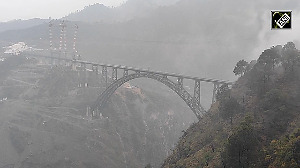Now that an Indian will be seen in Formula One, it is time for one to sharpen the database on the elite motorsport event.
Here are some of the words that will ring in the ears on Sundays as one reclines on the sofa to catch Narain Karthikeyan on the telly.
Names:
FIA: The Federation International d'Automobile, the ruling body of motorsport based in Switzerland.
Scuderia Ferrari: The racing division of Ferrari automobile company. It is Italian for "Ferrari Stable," or "Team Ferrari", founded by Enzo Ferrari in 1929 as a sponsor for amateur drivers.
Maranello: A town in northern Italy near Modena with a tiny population of about 15,000, best known as the home of Ferrari motorcars and Scuderia Ferrari.
Silverstone: In Northamptonshire in England, venue of first Formula One Grand Prix in 1950. Though motor racing has been on before, this British Grand Prix marks the start of F1 championship era.
Dates:
1950 - First modern day Formula One championship. Giuseppe Farina and Juan Manuel Fangio share the title.
1957 - Fangio, driving a Maserati, races to his fifth and final title by winning four of the five races.
1959 - Australian Jack Brabham wins with a rear-engined car, Cooper.
1964 - John Surtee becomes the first World Champion on both two wheels and four.
1970 - Jochen Rindt, driving for Lotus, becomes the first, and hopefully the last, posthumous champion.
1972 - Emerson Fittipaldi becomes the youngest world champion ever in a Lotus.
1974 - McLaren claim their first title with Fittipaldi driving for them.
1975 - Nikki Lauda win his first title. He would go on to win another two years later but not before bouncing back from a terrible accident at the Nurburgring in 1976.
1985 - Alain Prost finally wins title with McLaren after 10 years of promise and toil.
1988 - Ayrton Senna win his first title, winning eight races as against McLaren teammate Prost's seven, marking one of the fiercest rivalries in F1 history.
1991 - Senna's third title, while Michael Schumacher debuts in a Jordan.
1992 - Nigel Mansell wins nine races to realise his dream of becoming world champion.
1994 - Senna is killed after hitting a wall in Imola. Schumacher claims his first title driving for Benetton.
2000 - Dawn of Ferrari domination as Schumacher wins the first title for the Scuderia since Jody Scheckter in 1979.
2004 - Schumacher becomes the first to claim seven titles.
Glossary of technical terms:
Aerodynamic force: The force created by a vehicle's movement through the air. It is the combination of aerodynamic drag and aerodynamic lift.
Downforce: The opposite of aerodynamic lift, sometimes referred to as negative lift. The force caused by the air over the wings to push the car into the ground, increasing grip and cornering speeds.
G-Force: The apparent increase in weight of an object due to gravitational forces. Centrifugal force is a type of G-force which keeps your clothes stuck to the outside of a spinning washing machine. In racing cars, it is the force pulling the drivers head to one side as the car corners.
Launch control: A form of traction control used at the start of the race for the best get-away. Parameters include start-finish line gradient, starting line grip, distance to first corner and clutch biting point.
Traction control: A means of electronically reducing the power to the driving wheels, to minimise wheel-spin, and maximise traction. This is usually done by matching the speed of the rear wheels to that of the front wheels by reducing the voltage to the spark plugs.
Apex: The inside part of a corner that is on the racing line.
Racing line: An imaginary line around a circuit that provides the quickest lap time. When turning into a right-handed corner, the quickest line is to enter on the left side of the track, turn in and 'touch' the apex and ease back out to the left side of the track. Opposite for left-handers.
Oversteer: Occurs when the wheels are turned, and the car does not turn at the same rate. Causes the rear of the car to take a wider apex, causing the car to spin in extreme conditions. Also called loose in the US.
Understeer: Occurs when the wheels are turned, and the car does not turn at the same rate. Causes the front of the car to take a wider apex than the driver's steering lock requires. Also called push, or tight in the US. Can be corrected by adding more front downforce, softening springs and rollbar, or reducing front tyre pressure. Extreme conditions cause a car to go straight on instead of turning for a corner.







